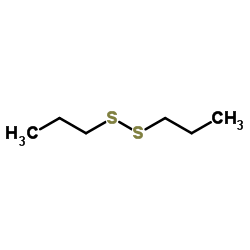Propyl disulfide

Propyl disulfide structure
|
Common Name | Propyl disulfide | ||
|---|---|---|---|---|
| CAS Number | 629-19-6 | Molecular Weight | 150.305 | |
| Density | 1.0±0.1 g/cm3 | Boiling Point | 190.9±9.0 °C at 760 mmHg | |
| Molecular Formula | C6H14S2 | Melting Point | −86 °C(lit.) | |
| MSDS | Chinese USA | Flash Point | 66.1±0.0 °C | |
|
Optimizations of packed sorbent and inlet temperature for large volume-direct aqueous injection-gas chromatography to determine high boiling volatile organic compounds in water.
J. Chromatogr. A. 1356 , 221-9, (2014) For the expanded application area, fast trace analysis of certain high boiling point (i.e., 150-250 °C) volatile organic compounds (HVOCs) in water, a large volume-direct aqueous injection-gas chromatography (LV-DAI-GC) method was optimized for the following ... |
|
|
Effect of processing conditions on the organosulfides of shallot (Allium cepa L. Aggregatum group).
J. Agric. Food Chem. 62(23) , 5296-304, (2014) There is a growing account of the health benefits of H2S as an endogenous cell-signaling molecule. H2S from organic polysulfides, in particular, is increasingly gaining attention for their beneficial effects to cardiovascular health. Here, we studied shallot ... |
|
|
Antiapoptotic effects of dietary antioxidants towards N-nitrosopiperidine and N-nitrosodibutylamine-induced apoptosis in HL-60 and HepG2 cells.
J. Appl. Toxicol. 29(5) , 403-13, (2009) The aim of this work was to determine the effect of vitamin C, diallyl disulfide (DADS) and dipropyl disulfide (DPDS) towards N-nitrosopiperidine (NPIP) and N-nitrosodibutylamine (NDBA)-induced apoptosis in human leukemia (HL-60) and hepatoma (HepG2) cell lin... |
|
|
Organosulfur compounds alone or in combination with vitamin C protect towards N-nitrosopiperidine- and N-nitrosodibutylamine-induced oxidative DNA damage in HepG2 cells.
Chem. Biol. Interact. 173(1) , 9-18, (2008) The aim of this study was to investigate the protective effects of organosulfur compounds (OSCs) alone or in combination with vitamin C towards N-nitrosopiperidine (NPIP) and N-nitrosodibutylamine (NDBA)-induced oxidative DNA damage in the single cell gel ele... |
|
|
A preliminary study on the action of genus Allium on thyroid 131iodide uptake in rats.
Rev. Esp. Fisiol. 48(1) , 59-60, (1992)
|
|
|
Biological activity of volatile di-n-propyl disulfide from seeds of neem, Azadirachta indica (Meliaceae), to two species of stored grain pests, Sitophilus oryzae (L.) and Tribolium castaneum (Herbst).
J. Econ. Entomol. 97(3) , 1142-7, (2004) Head space volatiles, including 73% di-n-propyl disulfide, were collected from freshly crushed neem seeds. This compound along with previously reported diallyl disulfide (di-2-propenyl disulfide) were toxic when applied topically or as a fumigant to Tribolium... |
|
|
Effects of oil-soluble organosulfur compounds from garlic on doxorubicin-induced lipid peroxidation.
Anticancer Drugs 9(3) , 291-4, (1998) Clinical efficacy of doxorubicin is compromised due to free radical generation leading to cardiac toxicity. Oil-soluble organosulfur compounds, diallyl sulfide (DAS), diallyl disulfide (DADS), dipropyl sulfide (DPS) and dipropyl disulfide (DPDS), present in g... |
|
|
Selective effects of diallyl disulfide, a sulfane sulfur precursor, in the liver and Ehrlich ascites tumor cells.
Eur. J. Pharmacol. 569(1-2) , 1-7, (2007) The present in vivo studies demonstrated that diallyl disulfide (DADS), occurring in garlic, elevated hepatic sulfane sulfur level and activities of gamma-cystathionase and 3-mercaptopyruvate sulfotransferase in healthy mice but did not affect the hepatic glu... |
|
|
Factors accounting for the variability in the behavioral response of the onion fly (Delia antiqua) to n-dipropyl disulfide.
J. Chem. Ecol. 29(9) , 2131-42, (2003) The onion fly Delia antiqua is a specialist herbivore attacking only onions and closely related Allium species. n-Dipropyl disulfide (Pr2S2) has long been known to be attractive to onion flies in the laboratory and in the field. However, the insect's response... |
|
|
Chicken manure increased concentration of organic sulfur compounds in field-grown onions.
J. Environ. Sci. Health B 44(5) , 481-7, (2009) A field study was conducted at Kentucky State University (KSU) Research Farm. The soil in five plots was mixed with sewage sludge, five plots were mixed with yard waste compost, five plots were mixed with laying hen manure each at 15 t acre(-1), and five unam... |